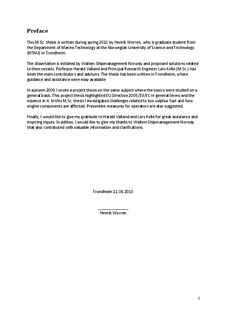Technical solutions regarding impementation of the EU directive 2005/33/EC concerning sulphur content of marine fuels
Master thesis
Permanent lenke
http://hdl.handle.net/11250/237845Utgivelsesdato
2010Metadata
Vis full innførselSamlinger
- Institutt for marin teknikk [3427]
Sammendrag
The objective of this diploma thesis is to assess the technical and operational challenges EU Directive 2005/33/EC will introduce. This is done using fundamental knowledge about naval architecture and marine diesel engines. Experiences on 0,1 % sulphur fuel in the maritime industry is limited, established standards and practices are few and is now being developed.
EU Directive 2005/33/EC is dictating vessels to use fuel with a maximum sulphur content of 0,1 % while in EU port. MGO (type DMA) is the only fuel available with a sulphur content below 0,1 %. Vessels managed by WSMN are calling an EU port frequently and have to do necessary modification to their vessels for safe compliance to the directive.
Today their vessels are carrying HFO and MDO, after complying with the directive, they shall carry HFO and MGO; MDO will be exchanged with MGO.
MGO got different properties from MDO. The main difference is low viscosity. Low viscosity can be compensated by cooling the fuel before use, installing a cooler before engine inlet. Poor lubricity is also an area of concern, lubricity additives available on the market may be used. Poor lubricity properties is from the production process in the refineries, hydrotreating is used to achieve 0,1 % sulphur content and is removing the fuel’s natural lubricity.
Marine fuels are tested against ISO 8217. This standard has several deficiencies and missing vital information on ignition/combustion properties. C/H (carbon/hydrogen) ratio is the most accurate indicator on this area. It is therefore recommended to upgrade a normal fuel sample analysis to include C/H ratio.
Equipment most affected by the new properties is pumps; injection pumps and booster-/supply pumps. Lower viscosity can increase the internal leakages and delivered flow and pressure will decrease. How each vessel is affected it mainly determined by the injection system’s condition. The better the condition is, its ability to deal with low viscosity fuels is better
On a general basis, manufacturers and class societies shall be consulted and modifications approved.
